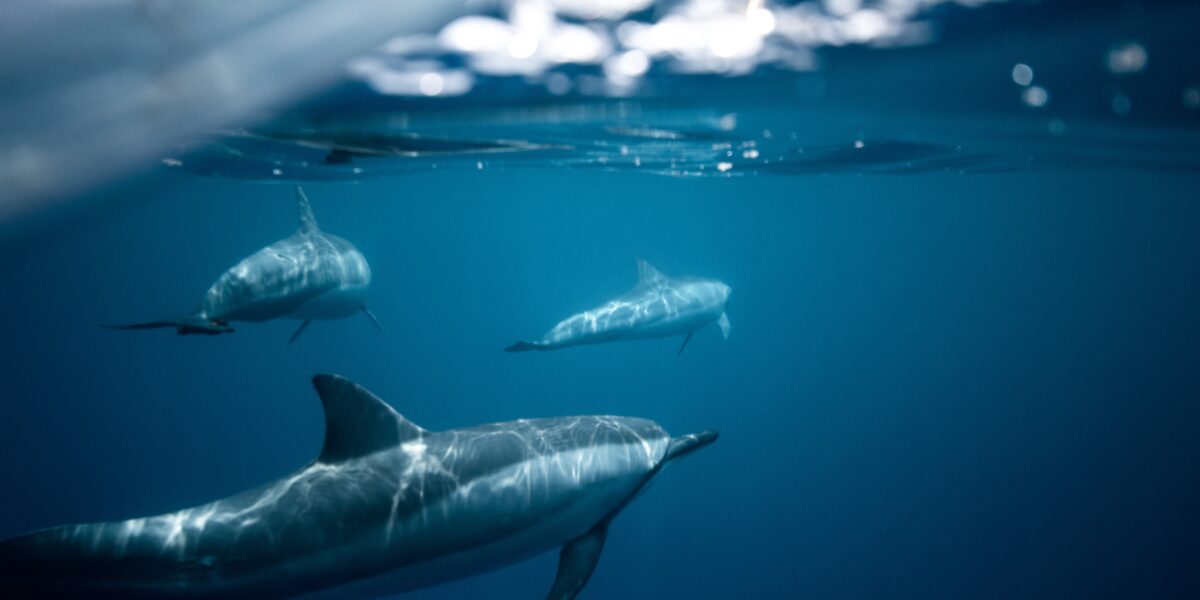Breaking Down Climate Geoengineering: Part 2
Part 1: Endless Unknowns
Part 3: Solar Radiation Modification
Part 4: Considering Ethics, Equity, and Justice
Carbon dioxide removal (CDR) is a form of climate geoengineering that seeks to remove carbon dioxide from the atmosphere. CDR targets the impact of greenhouse gas emissions by reducing and removing atmospheric carbon dioxide via long and short-term storage. CDR can be considered land-based or ocean-based, depending on the material and systems used to capture and store the gas. An emphasis on land-based CDR has been predominant in these conversations but interest in harnessing ocean CDR is increasing, with attention on enhanced natural and mechanical and chemical projects.
Natural systems already remove carbon dioxide from the atmosphere
The ocean is a natural carbon sink, capturing 25% of atmospheric carbon dioxide and 90% of the earth’s excess heat through natural processes like photosynthesis and absorption. These systems have helped maintain global temperature, but are becoming overloaded due to the increase in atmospheric carbon dioxide and other greenhouse gases from fossil fuel emissions. This increased uptake has begun to affect the chemistry of the ocean, causing ocean acidification, biodiversity loss, and new ecosystem patterns. Rebuilding biodiversity and ecosystems paired with a reduction of fossil fuels will strengthen the planet against climate change.
Carbon dioxide removal, through new plant and tree growth, can occur both on land and in ocean ecosystems. Afforestation is the creation of new forests or ocean ecosystems, like mangroves, in areas that have historically not contained such plants, while reforestation seeks to reintroduce trees and other plants in locations that had been converted to a different use, like farmland, mining, or development, or after loss due to pollution.
Marine debris, plastic, and water pollution have directly contributed to most seagrass and mangrove loss. The Clean Water Act in the United States, and other efforts have worked to reduce such pollution and allow reforestation. These terms have been generally used to describe land-based forests, but can also include ocean-based ecosystems like mangroves, seagrasses, salt marshes, or seaweed.
The Promise:
Trees, mangroves, seagrasses, and similar plants are carbon sinks, using and sequestering carbon dioxide naturally through photosynthesis. Ocean CDR often highlights ‘blue carbon,’ or carbon dioxide sequestered in the ocean. One of the most effective blue carbon ecosystems is mangroves, which sequester carbon in their bark, root system, and soil, storing up to 10 times more carbon than forests on land. Mangroves provide numerous environmental co-benefits to local communities and coastal ecosystems, preventing long-term degradation and erosion as well as moderating the impact of storms and waves on the coast. Mangrove forests also create habitats for various terrestrial, aquatic, and avian animals in the plant’s root system and branches. Such projects can also be used to directly reverse the effects of deforestation or storms, restoring coastlines and land that has lost tree and plant cover.
The Threat:
Risks accompanying these projects stem from the temporary storage of naturally sequestered carbon dioxide. As coastal land use changes and ocean ecosystems are disturbed for development, travel, industry, or by strengthening storms, carbon stored in soils will be released into the ocean water and the atmosphere. These projects are also prone to biodiversity and genetic diversity loss in favor of quickly growing species, increasing the risk for disease and large die outs. Restoration projects can be energy intensive and require fossil fuels for transportation and machinery for maintenance. Restoring coastal ecosystems through these nature-based solutions without appropriate consideration for the local communities may result in land grabs and disadvantage communities that have had the least contribution to climate change. Strong community relations and stakeholder engagement with Indigenous people and local communities are key to ensuring equity and justice in natural ocean CDR efforts.
Seaweed Cultivation aims to plant kelp and macroalgae to filter carbon dioxide from the water and store it in biomass through photosynthesis. This carbon-rich seaweed can then be farmed and used in products or food or sunk to the bottom of the ocean and sequestered.
The Promise:
Seaweed and similar large ocean plants are fast growing and present in regions around the world. Compared to afforestation or reforestation efforts, the oceanic habitat of seaweed makes it not susceptible to fire, encroachment, or other threats to terrestrial forests. Seaweed sequesters high amounts of carbon dioxide and has a variety of uses after growth. Through removing water-based carbon dioxide, seaweed can help regions work against ocean acidification and provide oxygen rich habitats for oceanic ecosystems. In addition to these environmental wins, seaweed also has climate adaptation benefits that can protect coastlines against erosion by dampening wave energy.
The Threat:
Seaweed carbon capture is distinct from other blue economy CDR processes, with the plant storing CO2 in its biomass, rather than transferring it into the sediment. As a result, the CO2 removal and storage potential for seaweed is limited by the plant. Domesticating wild seaweed through seaweed cultivation may decrease the plant’s genetic diversity, increasing the potential for disease and large die-outs. In addition, current proposed methods of seaweed cultivation include growing plants in the water on artificial material, like rope, and in shallow waters. This may prevent light and nutrients from habitats in the water below the seaweed and cause harm to those ecosystems including entanglements. The seaweed itself is also vulnerable to degradation due to water quality issues and predation. Large projects aiming to sink the seaweed into the ocean currently expect to sink the rope or artificial material as well, potentially polluting the water when the seaweed sinks. This type of project is also anticipated to experience cost constraints, limiting scalability. Further research is needed to determine the best way to cultivate seaweed and gain the beneficial promises while minimizing the anticipated threats and unintended consequences.
Overall, the recovery of ocean and coastal ecosystems through mangroves, seagrasses, salt marsh ecosystems, and seaweed cultivation aims to increase and restore the ability of the Earth’s natural systems to process and store atmospheric carbon dioxide. Biodiversity loss from climate change is compounded with biodiversity loss from human activities, like deforestation, decreasing the Earth’s resilience to climate change.
In 2018, the Intergovernmental Science-Policy Platform on Biodiversity and Ecosystem Services (IPBES) reported that two thirds of ocean ecosystems are damaged, degraded, or altered. This number will increase with sea level rise, ocean acidification, deep seabed mining, and anthropogenic climate change impacts. Natural carbon dioxide removal methods will benefit from increasing biodiversity and restoring ecosystems. Seaweed cultivation is a burgeoning area of study that would benefit from targeted research. Thoughtful restoration and protection of ocean ecosystems has immediate potential to mitigate the effects of climate change via emissions reductions paired with co-benefits.
Enhancing natural ocean processes for climate change mitigation
In addition to natural processes, researchers are investigating methods of enhancing natural carbon dioxide removal, encouraging the ocean’s carbon dioxide uptake. Three ocean climate geoengineering projects fall within this category of enhancing natural processes: ocean alkalinity enhancement, nutrient fertilization, and artificial upwelling and downwelling.
Ocean Alkalinity Enhancement (OAE) is a CDR method that aims to remove ocean carbon dioxide by accelerating the natural weathering reactions of minerals. These weathering reactions use carbon dioxide and create solid material. Current OAE techniques capture carbon dioxide with alkaline rocks, i.e. lime or olivine, or through an electrochemical process.
The Promise:
Based on natural rock weathering processes, OAE is scalable and offers a permanent method of carbon dioxide removal. The reaction between the gas and mineral creates deposits that are anticipated to increase the buffering capacity of the ocean, in turn decreasing ocean acidification. The increase of mineral deposits in the ocean may also increase ocean productivity.
The Threat:
The success of the weathering reaction is dependent on the availability and distribution of the minerals. An uneven distribution of minerals and regional sensitivities to the decrease in carbon dioxide may negatively impact the ocean environment. In addition, the quantity of minerals needed for OAE are most likely to be sourced from terrestrial mines, and will require transportation to coastal regions for use. Increasing the alkalinity of the ocean will modify ocean pH, also affecting biological processes. Ocean alkalinity enhancement has not seen as many field experiments or as much research as land-based weathering, and the impacts of this method are better known for land-based weathering.
Nutrient Fertilization proposes adding iron and other nutrients into the ocean to encourage the growth of phytoplankton. Taking advantage of a natural process, phytoplankton readily take up atmospheric carbon dioxide and sink to the bottom of the ocean. In 2008, nations at the UN Convention on Biological Diversity agreed to a precautionary moratorium on the practice to allow for the scientific community to better understand the pros and cons of such projects.
The Promise:
In addition to removing atmospheric carbon dioxide, nutrient fertilization may temporarily reduce ocean acidification and increase fish stocks. Phytoplankton are a food source for many fish, and the increased availability of food may increase the amount of fish in the regions where the projects are performed.
The Threat:
Studies remain limited on nutrient fertilization and recognize the many unknowns about long term effects, co-benefits, and permanence of this CDR method. Nutrient fertilization projects may require large amounts of materials in the form of iron, phosphorus, and nitrogen. Sourcing these materials may require additional mining, production, and transportation. This could negate the impact of the positive CDR and harm other ecosystems on the planet due to mining extraction. In addition, the growth of phytoplankton may result in harmful algal blooms, reduce the oxygen in the ocean, and increase the production of methane, a GHG that traps 10 times the amount of heat compared to carbon dioxide.
The natural mixing of the ocean through upwelling and downwelling brings water from the surface to the sediment, distributing temperature and nutrients to the different regions of the ocean. Artificial Upwelling and Downwelling aims to use a physical mechanism to speed up and encourage this mixing, increasing the mixing of ocean water to bring carbon dioxide rich surface water to the deep ocean, and cold, nutrient rich water to the surface. This is anticipated to encourage the growth of phytoplankton and photosynthesis to remove carbon dioxide from the atmosphere. Current proposed mechanisms include using vertical pipes and pumps to draw water from the bottom of the ocean to the top.
The Promise:
Artificial upwelling and downwelling is proposed as the enhancement of a natural system. This planned movement of water may help avoid the side effects of increased phytoplankton growth like low oxygen zones and excess nutrients by increasing ocean mixing. In warmer regions, this method may help cool surface temperatures and slow coral bleaching.
The Threat:
This method of artificial mixing has seen limited experiments and field tests focused on small scales and for limited time periods. Early research indicates that on the whole, artificial upwelling and downwelling have a low CDR potential and provide temporary sequestration of carbon dioxide. This temporary storage is a result of the upwelling and downwelling cycle. Any carbon dioxide that moves to the bottom of the ocean via downwelling is likely to upwell at some other point in time. In addition, this method also sees the potential for a termination risk. If the artificial pump fails, is discontinued, or lacks funding, increased nutrients and carbon dioxide at the surface may increase methane and nitrous oxide concentrations as well as ocean acidification. The current proposed mechanism for artificial ocean mixing requires a pipe system, pumps, and an external energy supply. The installment of these pipes is likely to require ships, an efficient source of energy, and maintenance.
Ocean CDR through Mechanical and Chemical Methods
Mechanical and chemical ocean CDR intervenes with natural processes, aiming to use technology to alter a natural system. Currently, seawater carbon extraction predominates the mechanical and chemical ocean CDR conversation, but other methods like artificial upwelling and downwelling, discussed above, could fall into this category as well.
Seawater Carbon Extraction, or Electrochemical CDR, aims to remove the carbon dioxide in ocean water and store it elsewhere, operating on similar principles to direct air carbon dioxide capture and storage. Proposed methods include using electrochemical processes to collect a gaseous form of carbon dioxide from seawater, and store that gas in a solid or liquid form in a geological formation or in ocean sediment.
The Promise:
This method of removing carbon dioxide from ocean water is expected to allow the ocean to take up more atmospheric carbon dioxide through natural processes. Studies on electrochemical CDR have indicated that with a renewable energy source, this method could be energy efficient. Removing carbon dioxide from ocean water is further expected to reverse or pause ocean acidification.
The Threat:
Early studies on seawater carbon extraction have primarily tested the concept in lab-based experimentation. As a result, the commercial application of this method remains highly theoretical, and potentially energy intensive. Research has also primarily focused on the chemical ability of carbon dioxide to be removed from seawater, with little research on the environmental risks. Current concerns include uncertainties about local ecosystem equilibrium shifts and the impact this process may have on marine life.
Is there a path forward for ocean CDR?
Many natural ocean CDR projects, like restoration and protection of coastal ecosystems, are supported by researched and known positive co-benefits to the environment and local communities. Additional research to understand the amount and length of time carbon can be stored through these projects is still needed, but the co-benefits are clear. Beyond natural ocean CDR, however, enhanced natural and mechanical and chemical ocean CDR have identifiable disadvantages which should be carefully considered before implementing any project on a large scale.
We are all stakeholders in the planet and will be affected by climate geoengineering projects as well as climate change. Decision makers, policymakers, investors, voters, and all stakeholders are key in determining if the risk of one climate geoengineering method outweighs the risk of another method or even the risk of climate change. Ocean CDR methods can help reduce atmospheric carbon dioxide, but should only be considered in addition to the direct reduction of carbon dioxide emissions.
Key Terms
Natural Climate Geoengineering: Natural projects (nature-based solutions or NbS) rely on ecosystem-based processes and functions that occur with limited or no human intervention. Such intervention is usually limited to afforestation, restoration or conservation of ecosystems.
Enhanced Natural Climate Geoengineering: Enhanced natural projects rely on ecosystem-based processes and functions, but are bolstered by designed and regular human intervention to increase the ability of the natural system to draw down carbon dioxide or modify sunlight, like pumping nutrients into the sea to force algal blooms that will take up carbon.
Mechanical and Chemical Climate Geoengineering: Mechanical and chemical geoengineered projects rely on human intervention and technology. These projects use physical or chemical processes to effect the desired change.







